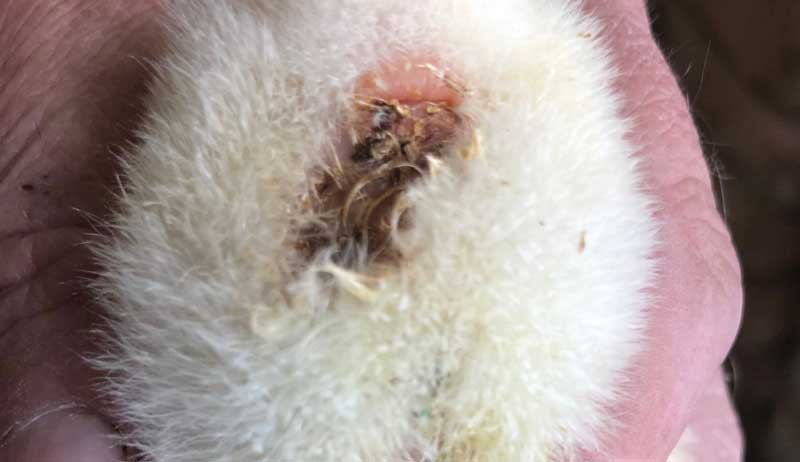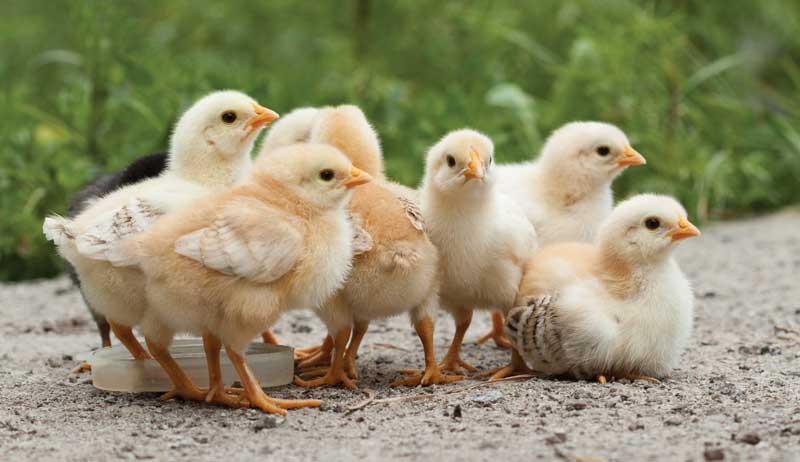
Spring always brings a degree of optimism. Don’t laugh. Really, it does. On the farm, the reason is simple. Despite all the crazy things that are happening elsewhere, spring on the farm carries thoughts of planting, rebirth and new growth. Springtime to chicken lovers across the country means that chicks are available once again.
For the past few winter months, chilly hens have been on hiatus. Most laying breeds will continue to lay through the winter. Egg numbers are usually down, and very few, if any, hens ever go broody. Many will molt in the fall so even the hatcheries don’t bother trying to supply chicks through the winter months. The point is that those of us who have chickens are finally finding healthy chicks available once again.
In fact, springtime means keepers even have breed choices. Maybe you raise your own chicks to replenish your flock, but the suburban chicken-keepers I know can’t have roosters and simply want to keep their flock numbers small in modest-sized houses and runs.
Almost everyone that keeps chickens must replace or add chicks to their flock from time to time, or annually. I consider myself a typical small-time keeper with 15 to 20 hens and no rooster. You may be larger or smaller or maybe just considering a few hens for the first time. Regardless, the excitement of getting new chicks is certainly fun and a time for optimism.
However, here’s the deal with new chicks. They come with a degree of responsibility. It can even be a great learning experience for youngsters if you also keep an eye on things. Day-old chicks, whether from a feed-supply store or chicks you order on your own, are just that. They are 1 day old, and they need attention. Specifically, they need constant feed, water, warmth and cover.
So, let’s assume you have all those basics taken care of. Don’t worry! Everything is cool. Well, indeed you may be right, but it’s extremely important to check on those baby chicks often during those first few hours and days, beginning as soon as you pick them up or when they’re delivered.
Your procedure may be different, but I purchase from a supplier that lets me look over the chicks from under his heat lamp at the feed-supply store. In that situation, I can look for all kinds of health and/or genetic anomalies. Each chick should be fluffy, dry and active. No crooked legs or toes and no bent or malformed beaks, etc. I also look for pasty butt. If you have never heard of pasty butt or have never seen it, you’re probably new to raising day-old chicks.
What It Is
Pasty butt isn’t a disease but, rather, a condition that can be fatal to the newly hatched chick if it remains unchecked. Pasty butt is also not a deformity or something that can spread from chick to chick. In the beginning stages, pasty butt is relatively easy to spot and relatively easy to remedy. Remember, that’s in the beginning, and you’ll want to observe your new chick additions closely and frequently.
Pasty butt is exactly as the name implies. There’s no discreet way to discuss a simple condition that displays itself as an accumulation of pasty, gooey manure that begins to gather at the baby chick’s vent. You should note that pasty butt most often occurs in young chicks up to about 2 weeks old.
It would be very uncommon in chicks 3 weeks old and nearly unheard after that.
Cases in chicks that old probably started earlier and went unnoticed when the chicks were younger. A baby chick is a tiny animal, especially bantams and some other breeds. That being the case, and since babies are covered with down, some poop (excreta) that doesn’t completely pass by the down near the vent may dry there and begin to gather each time the little hen or rooster poops. Pasting can eventually clog the vent causing the chick to go off feed and water, resulting in weakness, lethargy and eventual death.
Early on, I stated that pasty butt isn’t a disease. However, it is, or can be, a sign of symptoms or conditions that must be remedied. Anything that causes diarrhea in chicks will very frequently manifest into a case of pasty butt. Some of the conditions that may contribute to pasting are:
- variable temperatures
- stress
- poor feed or diet
- poor digestion that may lead to difficulties with high protein starter
- any number of bacterial or viral diseases
Let’s deal with each of these separately. 
Temperature
Temperature within the brooder box is as important as any of these factors and is usually the easiest to monitor. In the beginning, the brooder box should be around 95 degrees, depending on the time of day. Use a safe heat lamp and watch the chicks.
If they cluster under the center of the light and peep loudly or often, it’s a sure thing that the chicks are too cold and they’re trying to warm themselves under the light. The solution is to simply lower the light or increase the wattage of the lamp. Be sure to minimize or eliminate any drafts by keeping the brooder indoors and watch the babies’ reactions.
If babies now form a ring around the edges of the light cast by the lamp, they’re plenty warm and can’t tolerate the very center of the light source where the heat is too extreme. Remember, be safe with light sources as they can be a fire hazard if too close to flammables.
Stress
Another concern can be stress. If you purchase baby birds from a feed-supply store, you can bet that they were hatched elsewhere and then sent through the U.S. postal service via same-day or next-day air. The result can be stressed baby chicks that have been away from a heat source, away from a natural mother hen and may have been handled poorly.
It’s best to bring your chicks home in a dark, closed cardboard box and in an enclosed and quiet vehicle. Have your brooder box ready with feed, water and warmth. As you place each chick in the brooder, check its vent and make sure it’s clear and clean from any initial stages of pasting.
This should be done at the store before purchase, if possible. If pasting is spotted, it can be dealt with right then and there. Put the chick in question back in your transport box, and take care of all the others so they begin to calm down and get used to their new digs. When all the others are settled its time to deal with the problem chick.
When chicks are just 1- or 2-days old the excreta probably hasn’t hardened and can be easily wiped with a warm, moist cloth. If the poop has begun to harden, hold the damp cloth on the clump long enough to soften the mass and again try to wipe it free.
The harder the mass is, the longer this will take. But it will come free, and it must. Just be gentle!
After removal, dry the chick’s butt with a paper towel using light, gentle pressure. Many chicken handlers will apply a tiny amount of olive oil or other lubricant with a fingertip to the area once dry. Now that a case of pasting has been noted, take special care to check on that chick and all your new chicks more frequently.
Read more: Start hatching your own chicks with an egg incubator!
Digestive Issues
In the case of disease or digestive problems, only a couple of courses of action work. A newly hatched chick has a slightly underdeveloped digestive system, so the best practice is to keep water and feed as clean as possible for the first two weeks. That is always true much beyond two weeks, but pullets and older birds have higher bacterial tolerances.
Fortunately, diseases in chicks are infrequent and to bring in a vet for a single chick or two isn’t financially feasible or even productive. The best practice is to purchase from reputable feed-supply store or hatchery and simply feed medicated chick starter for the first two weeks or more.
Most feed-supply stores carry medicated chick starter at a reasonable price. The medication will at least prevent coccidiosis and other minor disorders.
Once pasty butt becomes evident, one is never totally sure of the cause. Treat the pasty butt, and nearly 100 percent of the time, the chick will fully recover if it isn’t related to some other serious disease. A true infestation of a virus or bacteria can be transmitted throughout your flock, so managing that situation is for a future discussion.
Poor Diet
The final condition we’ll discuss that may manifest as pasty butt is poor feed or diet. I can’t stress enough that you should make every effort to keep chicken starter clean, dry and free of mold. Any of those could cause digestive disorders and stress to the young chicks’ systems. Again, we’re only here to discuss pasty butt, but this involves its prevention. Prevention is always better than a cure.
If you have spotted pasty butt and you’re sure all other factors are at acceptable levels, check their feed. Feeding a probiotic recommended by your feed-supply store and adding some corn meal to the chick starter is another alternative. Lastly, store your feed in a container that keeps out rodents that might urinate and soil otherwise clean appearing feed.
The treatment of pasty butt is quite simple if you make constant observations when cleaning brooders, feeding, watering or just making frequent stops. Cleanliness and keeping the temperature right until the chicks are fully feathered—at about 8 weeks—are all best practices.
The bottom line is that pasty butt is common and normally a minor issue if you keep on top of the situation and its possible causes. By the way, chicks raised in natural situations by the mother hen almost never experience pasty butt.
Good luck with your new chicks, and don’t let a case or two of pasty butt shoot down that springtime optimism.
This article originally appeared in the March/April 2023 issue of Chickens magazine.




